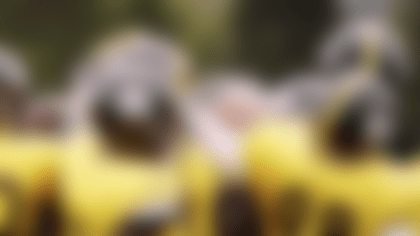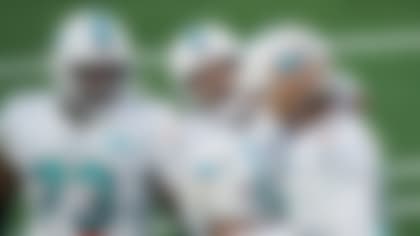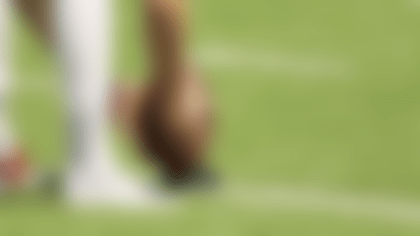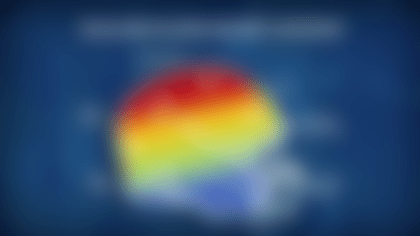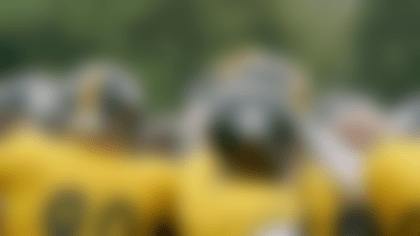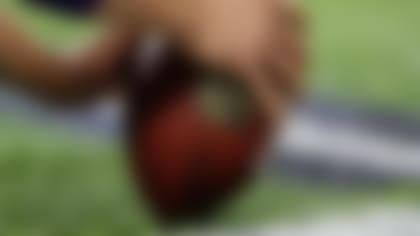A Constant Evolution
As the NFL learns more about player health and safety, the league evaluates and changes rules to evolve the game and try to improve protections for players. Since 2002 alone, the NFL has made over 50 rules changes intended to eliminate potentially dangerous tactics and reduce the risk of injuries.
2024
- Updates to the kickoff play, with all kicking team members other than the kicker now lining up at the receiving team's 40-yard line. The returning team will field up to two returners allowed inside the 20-yard line in the "landing zone," and the rest of the team will line up in a "setup zone" between the 30- and 35-yard line. Play will begin when the ball is either caught or hits the ground in the landing zone, or is returned from the end zone. Any kick that hits in the landing zone must be returned. Fair catches will no longer be allowed. Set up and landing zones do not change after penalties or a safety, only the spot where the ball is kicked changes. Onside kicks will be permitted for the trailing team in the 4th quarter.
- Eliminates the swivel hip-drop tackle, when a defender grabs the runner with both hands or wraps the runner with both arms and also unweights himself by swiveling and dropping his hips and/or lower body, landing on and trapping the runner's leg(s). A violation will result in a 15-yard penalty if flagged in a game.
2023
- Puts ball in play at the receiving team's 25-yard line if there is a fair catch on a free kick (kickoff and safety kick) behind the receiving team's 25-yard line, which should reduce injuries while not changing the fundamentals of the kickoff itself.
- Expands Impermissible Use of the Helmet, making it a foul for players to use their helmet to "butt, ram, spear" or make forcible contact to opponents' head or neck area in any way. This builds on the existing Impermissible Use of the Helmet rules which prohibits a player from lowering his head to initiate and make contact with his helmet against an opponent.
2020
- Expands defenseless player protection to include a kickoff or punt returner who will now be afforded the same protection as a pass receiver – both before, during, and after the opportunity to receive the kick. The protection extends until he can avoid or ward off impending contact from an opponent.
- Emphasizes removing certain illegal techniques from line play, such as using the helmet as part of a bull rush, or any block by an offensive lineman that involves initiating contact with the helmet. Game officials will continue to focus on identifying fouls in line play, specifically mobile blocks, cut blocks, and certain pass rush techniques, where initiating contact with the helmet occurs.
2019
- Made permanent the kickoff rule changes that were implemented during the 2018 season.
- Expanded protection to defenseless players, making it a foul if a player initiates a block when his path is toward or parallel to his own end line and makes forcible contact to his opponent with his helmet, forearm, or shoulder.
2018
- Makes permanent the playing rule that changes the spot of the next snap after a touchback resulting from a free kick to the 25-yard line.
- It is a foul if a player lowers his head to initiate and make contact with his helmet against an opponent. It is a penalty that will result in the loss of 15 yards. If the foul is by the defense, it is also an automatic first down. The player may be disqualified.
- Modifies the kickoff play for one year only.
2017
- Prohibits the "leaper" block attempt on field goal and extra point plays.
- Extends the rule changing the spot of the next snap after a touchback resulting from a free kick to the 25-yard line for another year.
- Gives a receiver running a pass route defenseless player protection.
- Prohibits crackback blocks by a backfield player who is in motion, even if he is not more than two yards outside the tackle when the ball is snapped.
- Reduces the length of overtime in the preseason and regular season to 10 minutes.
2016
- All chop blocks are prohibited.
- The horse collar tackle rule is expanded to include when a defender grabs the jersey at the name plate or above and pulls a runner toward the ground.
- In an effort to increase touchbacks, the spot of the next snap after a touchback resulting from a kickoff is moved from the 20- to the 25-yard line.
2015
- Rules prohibiting illegal "peel back" blocks are extended to cover all offensive players.
- Offensive backs are prohibited from chopping a defensive player engaged above the waist by another offensive player outside the tackle box.
- Defenseless player protections are expanded to cover the intended receiver of a pass in the immediate continuing action following an interception.
- When a team presents a punt, field-goal or try kick formation, defenders are prohibited from pushing teammates on the line of scrimmage.
2014
- Clipping and unnecessary roughness penalties are expanded to prohibit blockers from rolling up on the side of a defender's leg.
2013
- Players are required to wear protective knee and thigh pads.
- It is illegal for a runner or tackler to initiate forcible contact by delivering a blow with the top or crown of his helmet against an opponent when both players are clearly outside the tackle box.
- "Peel back" blocks below the waist are illegal inside the tackle box.
- The list of "defenseless players" is expanded to include long snappers on field goals and PATs (point after touchdowns).
- The "bunch" formation is eliminated on field goals and PATs. No more than six defenders may be on the line of scrimmage on either side of the snapper at the snap for these plays.
2012
- The list of "defenseless players" is expanded to include defensive players on crackback blocks, making it illegal to hit them in the head or neck area.
2011
- The restraining line for the kicking team is moved from the 30- to the 35-yard line in an effort to increase touchbacks.
- All kicking team players other than the kicker must be lined up no more than five yards behind their restraining line, eliminating the 15- to 20-yard running "head start" that had become customary for many players.
- The list of "defenseless players" is expanded to include: a kicker/punter during the kick or during the return; a quarterback at any time after a change of possession; and a player who receives a "blindside" block when the blocker is moving toward his own endline and approaches the opponent from behind or from the side. Previously, these players were protected against blows to the head, but not against blows delivered by an opponent with the top/crown or forehead/"hairline" parts of the helmet against other parts of the body.
- A receiver who has completed a catch is a "defenseless player" until he has had time to protect himself or has clearly become a runner. A receiver/runner is no longer defenseless if he is able to avoid or ward off the impending contact of an opponent. Previously, the receiver who had completed a catch was protected against an opponent who launched and delivered a blow to the receiver's head.
2010
- During a field-goal attempt, punt or try-kick, a defensive team player who is within one yard of the line of scrimmage at the snap must have his entire body outside the snapper's shoulder pads.
- After a half has expired, dead ball personal fouls by either team will be enforced on the succeeding kickoff.
- A player who has just completed a catch is protected from blows to the head or neck by an opponent who launches.
- All "defenseless players" are protected from blows to the head delivered by an opponent's helmet, forearm or shoulder.
- Kickers and punters during the kick and return, and quarterbacks after a change of possession, are protected from blows to the head delivered by an opponent's helmet, forearm or shoulder, instead of just helmet-to-helmet contact.
- The ball is declared dead at the spot if a runner's helmet comes completely off.
2009
- Teams are not permitted to intentionally form a wedge of more than two players on a kickoff return in an attempt to block for the runner.
- The "bunch" formation on kickoffs is eliminated. The kickoff team must have at least three players outside each hash mark, one of whom must be outside the yard-line number.
- It is an illegal "blindside" block if the blocker is moving toward his own endline and approaches the opponent from behind or from the side, and the initial force of the contact by the blocker's helmet, forearm or shoulder is to the head or neck area of an opponent.
- It is an illegal hit on a defenseless receiver if the initial force of the contact by the defender's helmet, forearm or shoulder is to the head or neck area of the receiver.
- The rule regarding low hits on passers is clarified:
A. A defender cannot initiate a roll or lunge and forcibly hit the passer in the knee area or below, even if he is being contacted by another player.
B. It is not a foul if the defender swipes, wraps or grabs a passer in the knee area or below in an attempt to tackle him.
2007
- A block below the waist against an eligible receiver while the quarterback is in the pocket is a 15-yard penalty instead of a 5-yard penalty (an illegal cut block).
2006
- Low hits on the quarterback are prohibited when a rushing defender has an opportunity to avoid such contact.
- Blocks in the back above the waist by the kicking team while the ball is in flight during a scrimmage kick are illegal.
- The definition of a "horse collar tackle" is expanded to include grabbing the inside collar of the jersey.
- During a field-goal attempt or a try, a defensive player who is within one yard of the line of scrimmage at the snap must have his helmet outside the snapper's shoulder pad.
- Personal or unsportsmanlike conduct fouls that occur during halftime or during intermission between the fourth period and an overtime period will be penalized on the ensuing kickoff.
- During a free kick, at least four kicking team players must be on each side of the kicker when the ball is kicked.
2005
- It is illegal to grab the inside collar of the shoulder pads to tackle a runner ("horse collar tackle").
- Unnecessarily running, diving into or throwing the body against a player who should not have reasonably anticipated such contact by an opponent is unnecessary roughness. Previously, the rule only protected a player who is out of the play.
- A kicker/punter must not be unnecessarily contacted by the receiving team through the end of the play or until he assumes a distinctly defensive position. An opponent may not unnecessarily initiate helmet-to-helmet contact to the kicker/punter during the kick or during the return.
- An offensive player who is aligned in the tackle box at the snap and moves to a position outside the box is prohibited from initiating contact on the side or below the waist of an opponent if the blocker is moving toward his own end line and approaches the opponent from behind or from the side ("peel back block"). The near shoulder of the blocker must be in front of his opponent's body.
2002
- The chop block technique is illegal on all kicking plays.
- It is illegal to hit a quarterback helmet-to-helmet any time after a change of possession.

